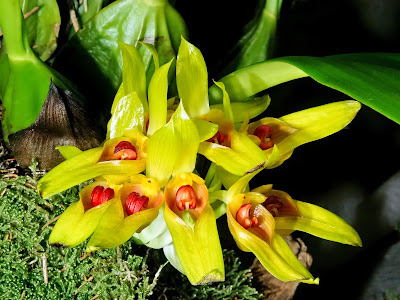Bulbophyllum graveolens was found in the Central Province of Papua New Guinea. Although it is quite rare, it occurs in different places from the central mountain belt towards the south. This orchid grows in the rain forests on the branches of trees of the lower and middle tiers at an altitude of 100-600 m.
Bulbophyllum graveolens, also called as The Very Fragrant Bulbophyllum, Bulbophyllum pachybulbum, Cirrhopetalum graveolens, Cirrhopetalum pachybulbum, Cirrhopetalum robustum, is a species of the genus Bulbophyllum. This species was described by J.J. Smith in 1912.
IDENTIFY BULBOPHYLLUM GRAVEOLENS
Bulbophyllum graveolens is native to New Guinea. This orchid was discovered in the Central Province of Papua New Guinea. Although it is quite rare, it was met in dispersed locations in Papua New Guinea, south of the central mountain range. It is always found in rain forests at heights of 100-600 m, where it usually grows on isolated positions on the branches of the lower trees and the middle layer of the forest.
It is a very large, single leafed epiphyte with numerous long white roots on a creeping rhizome. It has an erect to arching, 9" (23 cm) long, slender, bracteate inflorescence with straight, ovoid to ellipsoid green, thick, fleshy and deeply grooved pseudobulbs of 6-10 cm long and 2.5 -4 cm in diameter. The leaves are 50-65 cm long and 9-10 cm wide, drooping or semi-raised, with a lanceolate shape to the egg-shaped, dark green, thick, stiff, leathery, pointed, and the base has a narrowing V-shaped petiole.
The Very Fragrant Bulbophyllum has an apical umbel of 8 to 9 long-lasting flowers that are held below the leaves occurring in the fall. The flowers do not open completely and are up to 5 cm long and 2 cm wide. Petals and sepals are waxy, yellow-green with darker veins and numerous red dots at the base. Lip small, dark scarlet, covered with hairs on top. Its lower part is orange with red spots. The column is yellow with red spots, the cap of the anther is bright yellow. Upper sepals are tilted forward, shaped like a hood. It is ovate, concave and pointed. The lateral sepals at the base are parted, and then joined together with each other by edges, forming a plate similar to a tongue. Petals are small, lanceolate. The lip is mobile, thick, fleshy, bent down.
CARE AND CULTURE BULBOPHYLLUM GRAVEOLENS
Cultural information should only be used as a guide, and should be to be adapted to suit you. Your physical location; where you grow your plants, how much time you have to devote to their care, and many other factors, will need to be taken into account. Only then can you decide on the cultural methods that best suit you and your plants.
Light:
Bulbophyllum graveolens needs a light level of 12000-23000 lux. The light should be filtered or dispersed, and the plants should not be exposed to the direct sunlight of the midday sun. Strong air movement should be ensured all the time.
Temperature:
It is a thermophilic plant. Throughout the year, the average day temperature is 27-31 ° C, and the average night temperature is 22-23 ° C, which gives a daily amplitude of 5-8 ° C.
Humidity:
The Very Fragrant Bulbophyllum needs a humidity level of 70-75% for most of the year, and increases in winter to 75-80%.
Substrate, growing media:
When choosing a method for growing Bulbophyllum graveolens, it is first of all necessary to understand that this orchid possesses a rather thin and very delicate root system, which is contraindicated in long-term drying. Plants can be grown attached to pieces of tree fern or cork, provided high humidity and daily watering are ensured. These plants are also grown in baskets or flat containers using a very loose, fast-drying substrate that undergoes very slow decomposition.
Repotting:
These plants react adversely to the violation of the root ball, so they should not be split or repotted when the base maintains a loose structure and provides good drainage. When repotting is necessary, it is best to choose the moment when new roots appear, in this case the plant will recover faster.
Watering:
During active growth, Bulbophyllum graveolens should only slightly dry out between waterings. Plants cultivated on rootstocks should be watered at least once a day in the summer, even more often in the hottest and most sunny days.
Fertilizer:
During the active growth period, weekly 1/4-1/2 of the recommended dose of fertilizer for orchids is fertilized. You can apply a balanced fertilizer all year round, but you can use a fertilizer with a high nitrogen content from spring to mid-summer, and switch to a fertilizer with a high content of phosphorus in late summer and autumn.
Rest period:
Bulbophyllum graveolens need less water in the winter, especially if they grow under the conditions of a dark, short day that occurs at moderate latitudes. They should dry somewhat between waterings, but they should not be dry for a longer period. Frequent morning fogging and rare, economical watering should allow the plant to go through a dry period of rest, while providing it with sufficient humidity. Fertilization should be reduced or eliminated until new growths appear and a more abundant spring watering begins.















COMMENTS